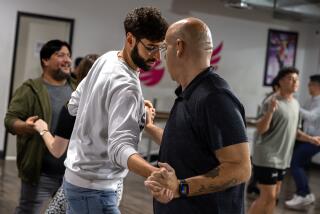Dance and Music Reviews : A Steamy, Riveting Study of the Tango
- Share via
With its swooning melodies, surging rhythms and suave hesitations, the tango permits couples to improvise an infinite variety of complex, quicksilver movements while exulting in some of the most urbanely sensuous attitudes imaginable.
Those who discovered the authentic tango tradition through local tours of the revue “Tango Argentino” in 1986 and 1987 can hurry with pleasure to the riveting new “Forever Tango,” which opened a five-day run Wednesday at Royce Hall, UCLA.
Three of the five couples are veterans of the previous tours, and the musicians are no less accomplished and persuasive.
Like its predecessor, to which it is not otherwise related, “Forever Tango”--choreographed by Gloria and Eduardo Arquimbau--offers a loose historical survey, some short dance-drama pieces and lots of musical selections. It traces the dance from its origins in the brothels of Buenos Aires at the beginning of the century to its “golden years” in the war-isolated Argentina of the 1940s, using a similar format of alternating dance and music.
Again, couples relate through pure virtuosic partnership and a variety of moods, often portraying erotic interplay with the men exacting submissive postures from the women. Indeed, at least one member of the audience shuddered to think what implications for real-life social relationships this machismo attitude-in-excelsus suggests.
Having a sleek, perfect body, however, is not a requisite for tango mastery. Some of the most difficult, fast and showy dancing was done by the middle-aged and somewhat hefty couple, Gloria and Eduardo, with her spinning in and out of his arms or matching the wild, circular movements of his legs.
Some of the riskiest, most dazzling dancing occurred in Sandor’s whirling overhead lifts of Miriam in the metaphoric “Romance del Bandoneon y la Noche.”
Otherwise the dancers impressed in the fluid, unpredictable sequences of flashing footwork, with kicks between the legs, ankles linked and released, legs swung out like pendulums or wound around one other in intricate patterns with split-second timing.
With cadential flourishes, women hopped onto their partners’ thighs or wrapped a leg caressingly over their hips. Men directed the women, dipped them in improbable balances and occasionally sent a wink and a kiss to the audience.
Supporting all this was the sweetly sad, intoxicating music played by the 11-member band, dominated by the mournful sound of the bandoneon, a small accordion. Virtuosic solo opportunities were presented by Lisandro Adrover, band leader and bandoneonist, and pianist Osvaldo Berlingieri. The glamorous Viviana Vigil and expressive Carlos Morel provided vocal solos.
More to Read
The biggest entertainment stories
Get our big stories about Hollywood, film, television, music, arts, culture and more right in your inbox as soon as they publish.
You may occasionally receive promotional content from the Los Angeles Times.










